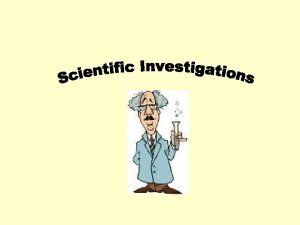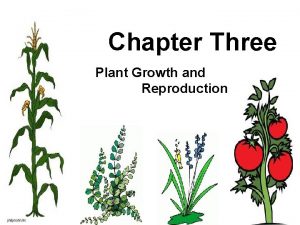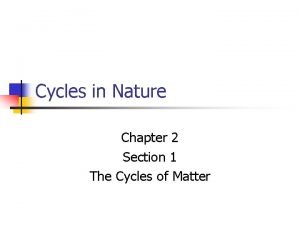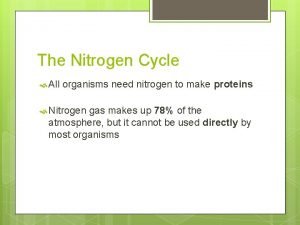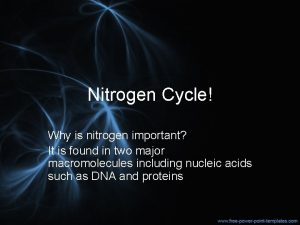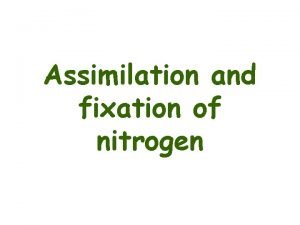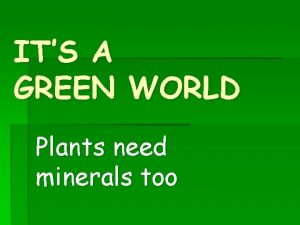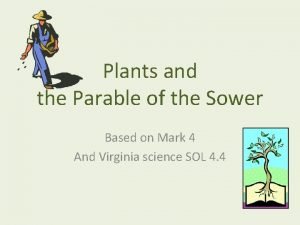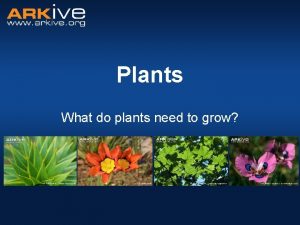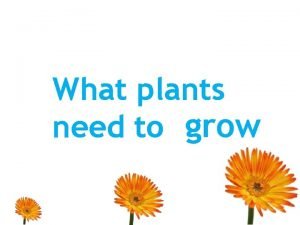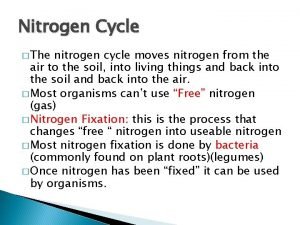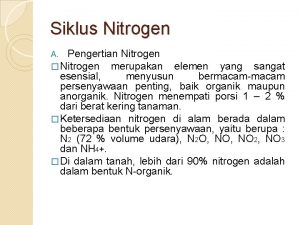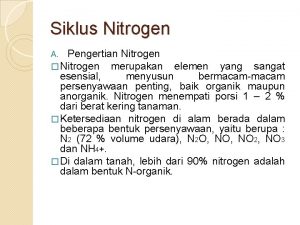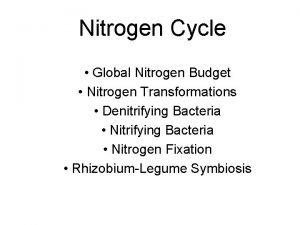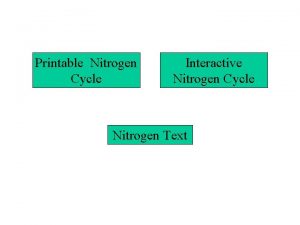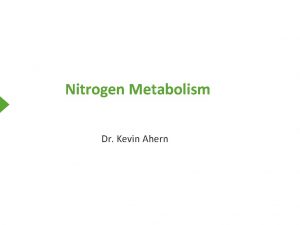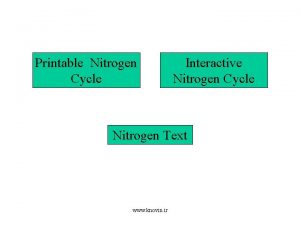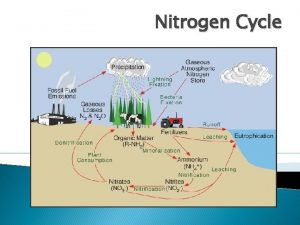Plants and nitrogen Plants need nitrogen to grow

















- Slides: 17

Plants and nitrogen • Plants need nitrogen to grow. • It’s present in DNA, RNA, the amino acids that make up proteins, ATP, chlorophyll and most vitamins. • The air is 78% nitrogen gas • BUT nitrogen gas CANNOT be taken up by plants – it is insoluble so cannot be absorbed • So the nitrogen cycle is essential to enable plants to get nitrogen in a form they CAN absorb

How can plants obtain nitrogen? • 2 ways: – Nitrification – Nitrogen fixation • Both require help from bacteria! 1. Nitrifying bacteria 2. Free-living nitrogen-fixing bacteria in the soil 3. Nitrogen-fixing bacteria in root nodules

Nitrifying bacteria • Decomposition by decomposers produces ammonia (NH 3) from the nitrogen in compounds like DNA, proteins etc. • This conversion process is called ammonification. • The ammonia is oxidised by nitrifying bacteria – First to NITRITE (NO 2 -) – Then to NITRATE (NO 3 -) • This process is called NITRIFICATION • Plant roots can absorb the nitrates • These can be combined with carbohydrates from photosynthesis to form amino acids & then proteins & other nitrogen-containing compounds.

Nitrogen-fixing bacteria in root nodules Leguminous plants have root nodules E. g. clover, beans, peas Nodules contain millions of nitrogen-fixing bacteria They have a symbiotic relationship with the plant i. e. both bacteria & plant benefit • They convert nitrogen gas in the soil into ammonia • They do this using an enzyme called nitrogenase • The plant can convert this ammonia directly into amino acids etc. as it is already inside the plant roots • •

Nitrogen-fixing bacteria in root nodules • The reduction of atmospheric nitrogen is a complex process that requires a large input of energy to proceed. • The nitrogen molecule is composed of two nitrogen atoms joined by a triple covalent bond, thus making the molecule highly inert and nonreactive. • Nitrogenase catalyses the breaking of this bond and the addition of three hydrogen atoms to each nitrogen atom. • The plant provides sugars from photosynthesis that are utilized by the nitrogen-fixing bacteria to produce the energy it needs for nitrogen fixation. • In exchange for these carbon sources, the bacteria provide fixed nitrogen to the host plant for its growth.

Free-living nitrogen-fixing bacteria • Free-living nitrogen-fixing bacteria also convert nitrogen gas in the soil into ammonia • These bacteria must find their own source of energy to do this, typically by oxidizing organic molecules released by other organisms or from decomposition. • The bacteria use the ammonia to make amino acids & proteins etc. • When the bacteria die, their proteins decompose, releasing ammonia back into the soil • This ammonia can be converted to nitrates by nitrifying bacteria, & nitrates can be absorbed by the plant roots

BAD bacteria! • Another type of bacteria use nitrates as an energy source and convert them into nitrogen gas • These are DENITRIFYING bacteria • DENITRIFICATION reduces the amount of nitrate in the soil – BAD for plants!

Lightning • The energy from lightning causes nitrogen gas (N 2) and water to combine to form ammonia (NH 3) and nitrates (NO 3). • Precipitation carries these to the ground, where they can be absorbed by plants

NITROGEN GAS (N 2) NITRIFYING BACTERIA NITRITE (NO 2 -) NITRIFYING BACTERIA NITRATE (NO 3 -) DEATH & DECOMPOSITION AMMONIA (NH 3) NITRIFICATION DENITRIFYING BACTERIA DECOMPOSITION (AMMONIFICATION) AMMONIA (NH 3) NITROGEN GAS (N 2) NITROGEN-FIXING BACTERIA IN ROOT NODULES NITROGEN FIXATION FREE-LIVING NITROGEN-FIXING BACTERIA NITROGEN FIXATION

Plants and nitrogen • Plants need ………………. to ……………. • It’s present in DNA, RNA, the ………………. . that make up proteins, ………, chlorophyll and most vitamins. • The air is ………% nitrogen gas • BUT nitrogen gas CANNOT be taken up by plants – it is ………………. . so ………………. be …………………. . • So the …………… is essential to enable plants to get nitrogen in a form they CAN …………. .

How can plants obtain nitrogen? • 2 ways: – ………………………… • Both require help from bacteria! 1. ………………… bacteria 2. Free-living ……………. bacteria in the soil 3. Nitrogen-fixing bacteria in ……………….

Nitrifying bacteria • ………… by decomposers produces ……………. . (NH 3) from the nitrogen in compounds like DNA, proteins etc. • This conversion process is called …………… • The ammonia is …………………. by ………… bacteria – First to ………………… (NO 2 -) – Then to …………………. . (NO 3 -) • This process is called …………. • Plant ……………. . can ……………… the …………………. • These can be combined with carbohydrates from …………… to form amino acids & then proteins & other nitrogen-containing compounds.

Nitrogen-fixing bacteria in root nodules ………… plants have root ………………. E. g. …………………. Nodules contain millions of ……………. . bacteria They have a ………… relationship with the plant i. e. both bacteria & plant benefit • They convert nitrogen ……. . in the ……… into ……………. . • They do this using an enzyme called …………………. . • The plant can ……………. this ammonia directly into …………………. . etc. as it is already ……………… the plant roots • •

Nitrogen-fixing bacteria in root nodules • The reduction of atmospheric nitrogen is a complex process that requires a large input of energy to proceed. • The nitrogen molecule is composed of two nitrogen atoms joined by a triple covalent bond, thus making the molecule highly inert and nonreactive. • Nitrogenase catalyses the breaking of this bond and the addition of three hydrogen atoms to each nitrogen atom. • The plant provides sugars from photosynthesis that are utilized by the nitrogen-fixing bacteria to produce the energy it needs for nitrogen fixation. • In exchange for these carbon sources, the bacteria provide fixed nitrogen to the host plant for its growth.

Free-living nitrogen-fixing bacteria • Free-living nitrogen-fixing bacteria also convert ………………. in the ………. into ………………… • These bacteria must find their own source of …………… to do this, typically by oxidizing organic molecules released by other organisms or from decomposition. • The bacteria use the ………………. to make ………………… & proteins etc. • When the bacteria ……. , their …………………. . , releasing …………………. back into the ………. . • This ammonia can be converted to ……………. . by ………………. bacteria, & nitrates can be ………………. . by the plant …………

BAD bacteria! • Another type of bacteria use ……………. as an ……………. and convert them into nitrogen …… • These are …………… bacteria • ……………. reduces the amount of nitrate in the soil – BAD for plants!

 How to get nitrogen into soil
How to get nitrogen into soil What makes plants grow
What makes plants grow What makes plants grow
What makes plants grow What makes plants grow
What makes plants grow What makes plants grow
What makes plants grow How do plants get nitrogen
How do plants get nitrogen How do animals get the nitrogen they need
How do animals get the nitrogen they need All organisms need nitrogen to
All organisms need nitrogen to Nitrogen in macromolecules
Nitrogen in macromolecules Nitrogen assimilation in plants
Nitrogen assimilation in plants Nitrogen plants
Nitrogen plants What minerals do plants need
What minerals do plants need Why do plants need roots
Why do plants need roots Characteristics of flowering and non flowering plants
Characteristics of flowering and non flowering plants Vascular plants vs nonvascular plants
Vascular plants vs nonvascular plants Non vascular plant reproduction
Non vascular plant reproduction C3 plant
C3 plant Jesus grew in wisdom
Jesus grew in wisdom

